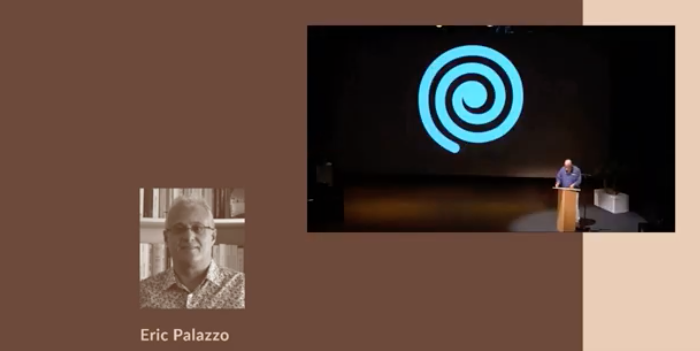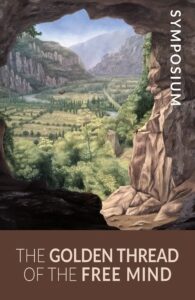GET ACCESS TO THE FULL SYMPOSIUM VIDEO (MORE THAN 7 HOURS) FOR € 10,-
Christian theology in the era of the Antiquity and the Middle Ages has rather poignantly placed the question of the freedom of the Spirit or, reversely, the spirit of freedom at the centre of their studies of the activation of the spiritual pursuit of Man, both on an individual basis as well as on a collective level.
In saying this I underline the fact that Christian theological thought in Antiquity and the Middle Ages has always differentiated itself from the gradual evolution over the centuries of the church as an institution on the one hand, and from dogmatic theology on the other. In such a way that even the Christian theology of the first centuries of our era and of the Middle Ages upheld the absolute necessity of the freedom of the Spirit in the spiritual development of every individual.
By definition, Spirit is freedom. In this talk I would like to validate this from a specific angle, namely that of the inspiration by the breath of God and the transfer of energy from this breath to humans in the context of the liturgy and the art (expressions) in the Middle Ages.
In order to follow my argument correctly, it is worth bearing in mind that the Christian theology of the early centuries and the Middle Ages makes no distinction between liturgy and art. Rituals are equated with forms of art and vice versa.
In my presentation today, I would like to focus on the subject of energy, specifically on one of its chief manifestations in Christian spirituality, the spiral. As a preliminary consideration to what will follow on the relationship between what in a recently published book, I have termed the Christ-energy and the spiral. I may mention that the spiral is viewed by theologians as the ideal symbol of Man on his spiritual journey. Because of his energy-based nature and his focus on higher spiritual subjects,
Man can ascend to God and complete his initiation path. In many examples the Christian liturgy and its spatial anchor in the church building bear witness to a lively interest in the spiral and in related and similar forms. Evidence of this is the presence of a labyrinth in many important medieval churches inviting a Christian member to start his spiritual path on the stone-flagged floor of the building.
From a Christian perspective, energy is a topic that is both essential to understand the creation of the world in a given society but also one that is difficult to grasp in all its complexity.
In our modern world, energy as a topic is primarily associated
with science and not with history, with the exception of the history of science itself, of course. On the basis of a strong intuition, the Christian philosophers of Antiquity and the Middle Ages perceived the fundamental character of energy and its all-encompassing importance in Christianity.
From a Christian perspective, energy aligns closely with the definition of the nature of God. To accentuate this energy, Christian authors in various texts emphasize time and again, and in various shades of meaning, the spiritual power, the movements, the virtue, the breath of the Spirit as well as the ascending upward movement of the spiral.
Energy is central to the definition of Christian cosmogony and plays a decisive role in the way the Christians of Antiquity and the Middle Ages thought about the world and the world’s relationship to God. Thinking about energy from a Christian perspective means affirming the freedom of the Spirit. For the theologians, it is primarily a journey, a following of the spiritual path of Man on the basis of the energy given to him by God, enabling him to go the way and behold an eschatological vision.
Numerous authors, among whom Augustine, agreed to define energy based on a reflection on the true nature of God. God, recognised as the source of every form of energy, and Himself a concentration of pure energy, has activated – or set in motion so to speak – a spiritual Force as His quality; as part of his Being. Not only to create the world but also to provide Man with the necessary energy to make his way on earth and to progress in the direction of the afterlife and the eschatological vision.
The energy nature of God is thus shared with Man, who is thereby given a responsibility. He is tasked with making good use of the spiritual energy transmitted by God. Not only to follow his spiritual path – he is the Homo viator after all (man on a quest) – but also with the aim of fully participating in the building of the Ecclesia, both on earth and in the heavens, and to be a participant in the employ of divine energy.
In this way, the energy given by God to Man emphasizes the question of the freedom that is closely linked to the Spirit and its activation in Man. The activation of a spiritual energy by God at the time of Creation and its transmission to Man for a specific purpose propelled Man forward through History or, more correctly, into history as the Bible recounts it.
The Christian ‘theology of energy’ is an explanation of a transcendental experience of this world, which takes Man beyond any historical narrative of his journey on earth. Through the divine energy, which is spiritual in nature because it rests on Christian virtues, Man enters in full freedom into ‘History’, the trail of which he follows until he leaves the ‘time of historiography’ to enter the age of eschatology (i.e., the end of the world).
In this way, Christian Man becomes an active energy without the absolute need to fully understand the meaning of the energy transfer he received from God. At the time of God’s Creation of the world and of Man, the energetic principle of exhalation gave rise to a dynamic movement, which from that moment on has been activated by God and Man jointly.
The two main dynamic channels of this energetic drive are: biblical history and the liturgy and its rituals. From a Christian perspective, this energy unites the use of it in time and space with the profound significance of Creation.
Energy is a presence, the presence of God before Creation, which accompanies and guides Man on earth on his spiritual path as well as in the hereafter in an eschatological vision that does not signify a return to the beginning of Creation but is rather a timeless being-present. From that point on, energy-in-motion is inseparable from the state of the energetic Force at rest, in stasis.
In a sense, these two energy states cannot be fathomed without seeing them as complementary and as representatives of different times or stages of God’s energetic activation. In an analogous way of thinking, the Christian energy concept definitively puts aside the option of seeing life and death as opposite poles. Indeed, not only has Christianity formulated death as a step towards a continuation of life for the believer, be it in a different way, but it has also formulated the presence of a specific energy force both in the process of life as well as in the state of both physical and spiritual death.
As the fragment from chapter 37 of the Book of Ezekiel on the valley of bones shows us, the breath of the Spirit gives life to bones and nerves and imparts strength to parts of a body that was never truly dead.
Within this biblical theological framework, the liturgy lends a poetic dimension to the way in which spiritual energy can be experienced. Beyond the sacramental, social and political effects – the rituals of the Church were certainly very influential in the construction of medieval society and of the Church on earth – the liturgy had the primary function to sacralise and ‘poetize’ the energy streams flowing from God to Man. The liturgy’s aim to sacralise this energy is directly related to the institution of the Christian liturgical cycle and the sacramental wayposts one must pass on one’s path to the eschatological revelation.
The spiritual energy which Man receives from God constitutes an important element for him to complete the journey that gives access to the eschatological revelation and at the same time liberates him completely. This energy, the nature of which is directly related to the nature of God and Christ, is a sine qua non condition (an essential condition) for the successful completion of the journey by the Homo viator.
The spiritual energy includes above all strength and the Christian virtues and it enables Man to activate body and mind thus to set out to behold Christ, enthroned in his majesty in the centre of the heavenly Jerusalem. Man has need of this energy because it represents the true nature of God and of Christ which he receives at communion after the consecration of the hosts in the eucharist ritual.
Man is a pilgrim and as such he is obliged to complete his inner pilgrimage as well as the assignment which requires him to build the Ecclesia. In both aspects, this God-given energy is indispensable and is the seed of the spiritual imprint of the journey and of the building of the Ecclesia. As such Man is on his way in the bosom of the pilgrim-Church, whose eternal movement is a representation of the movement brought forth by God at the Creation of the world.
The eschatological revelation is what awaits Man in the afterlife, as it also awaits the active Church on its pilgrimage. The Church builds itself in the movement produced by the divine energy transmitted to Man who must make proper use of it and in himself embody the spiritual virtues which this energy bears in itself, because it is a full part of the true nature of God.
The Christian theology of Antiquity and the Middle Ages invites us to think differently about our relationship with the power of the Spirit and about the aspect of freedom.
With regard to this subject and the examples we have explored, this relationship is embodied – if I may say so – in the breath of the energy of God, passed on to Man so that he may make full use of the freedom he has in his use of this energy transmission for the specific purpose of actually going his spiritual path on earth and in heaven.
The wandering Man of Christian theology is free, and is propelled by the breath of the Spirit which God has passed on to him in order to make him aware of his spirit of freedom, in the realization of his path and in the perception of the energy that is his due.
Eric Palazzo, professor in History of Medieval art at the University of Poitiers and Princeton and author of Peindre c’est prier. Anthropologie de la prière chrétienne (Painting is praying. Anthropology of the Christian prayer), 2016 and Le souffle de Dieu (The breath of God), 2020
GET ACCESS TO THE FULL SYMPOSIUM VIDEO (MORE THAN 7 HOURS) FOR € 10,-

